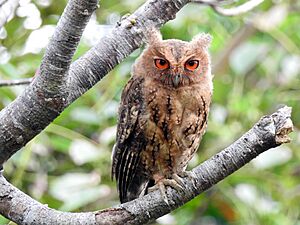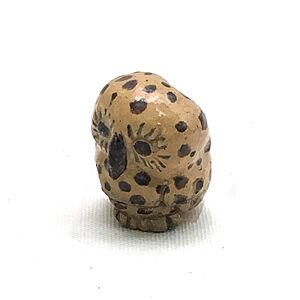Japanese scops owl facts for kids
Quick facts for kids Japanese scops owl |
|
|---|---|
 |
|
| Otus semitorques pryeri on Okinawa | |
| Conservation status | |
| Scientific classification | |
| Genus: |
Otus
|
| Species: |
semitorques
|
The Japanese scops-owl (scientific name: Otus semitorques) is a small owl. It belongs to the true owl family, called Strigidae. This owl lives in Japan, China, Korea, and Russia.
Japanese scops-owls have grey-brown feathers and bright red eyes. They also have noticeable ear tufts on their heads. These owls live in forests, woodlands, and mountains. They are carnivores, meaning they eat meat. Their main foods are invertebrates (like insects) and small rodents. They build their nests in hollow trees. Male owls use their calls to find mates or scare away enemies.
Contents
About the Japanese Scops-Owl
The Japanese scops-owl was first described in 1845 by two scientists, Temminck and Schlegel. It is part of the true owl family, Strigidae. This family includes about 90% of all owl species. The other 10% are barn owls.
The Japanese scops-owl is in a group called Otus. This is the largest group of owls, with 59 different species. These owls are found across Europe, Asia, and Africa. The name Otus comes from Latin and means "small-eared owl." The Japanese scops-owl is closely related to the Indian scops-owl.
Three types, or subspecies, of Japanese scops-owls are known:
- O. s. ussuriensis: Found in northeast China, southeast Siberia, and the Korean Peninsula.
- O. s. semitorques: Lives in the Kuril Islands and from Hokkaido south to Yakushima in Japan.
- O. s. pryeri: Found from Okinawa to Iriomote in southern Japan.
What Does the Japanese Scops-Owl Look Like?
Japanese scops-owls are about 16.5 to 30 centimeters (6.5 to 12 inches) tall. Their wingspan (how wide their wings are when spread out) is about 60 to 66 centimeters (23.5 to 26 inches). They weigh between 130 and 200 grams (4.5 to 7 ounces).
Their feathers are grey and brown. This helps them blend in with tree bark, making them hard to spot. Their wings are long and pointed. Like most scops-owls, they have clear ear tufts. They have a pale grey-brown face and bright red eyes. Their feet are green with feathers on their toes, and their beak is also green.
These owls can fly very fast, up to 80 kilometers per hour (50 miles per hour).
Where Do Japanese Scops-Owls Live?
Japanese scops-owls live in forests, woodlands, and mountains. They can be found from sea level up to 900 meters high. Sometimes, you can even spot them in parks and gardens in villages.
These owls usually stay in the same area all year. However, they might move to lower places during winter. Japanese scops-owls are found in Japan, Korea, China, and Russia. Different subspecies live in different parts of these countries:
- Otus semitorques ussriensis lives in Sakhalin, Ussuriland, and Northeastern China.
- Otus semitorques semitorques lives in the Korean Peninsula, Jeju Island, Kuril Islands, and many Japanese islands like Hokkaido and Yakushima.
- Otus semitorques pryeri lives in the Izu Islands and Ryukyu Islands.
Japanese Scops-Owl Behavior
Hunting and Eating Habits
Japanese scops-owls mostly eat invertebrates like insects, millipedes, and crabs. They also eat small rodents such as voles and mice. Sometimes, they hunt small birds, frogs, lizards, snakes, and fish.
They are active hunters and often look for food while flying. They might also sit on a branch and wait for prey. When they hunt rodents, they often look for young ones in nests because they are easier to catch. These owls hunt at night because their eyes are made for seeing in the dark. They use their excellent hearing to find prey.
Reproduction and Life Cycle
Japanese scops-owls are usually alone until it's time to breed. They form pairs and stay together during the breeding season. The male owl calls to attract a female to a nest he has found or prepared. Males often use old nests built by other birds. Females choose a mate based on his nest-building skills and how much food is in the nest.
Japanese scops-owls nest from March to July. They usually nest in holes in trees or in nest boxes. Females lay their eggs in March. The female sits on the eggs for 3 to 4 weeks, and the male brings her food. The young owls, called owlets, leave the nest in May and June. When they are born, they are naked with only a few soft down feathers. They can fly when they are 4 to 6 weeks old.
Females usually lay 2 to 5 eggs per season. On average, 1 to 3 eggs will hatch. Snakes are a main predator of their eggs. Japanese scops-owls can live for about 12 years.
Owl Sounds
Japanese scops-owls make many different sounds. These include screeches, meows, hoots, and chatters. They often screech to scare away predators. Males usually make a deep, repeated "whook" sound. Other calls are described as "kwe" or "koo" notes. They also repeat "kwee-kwee" and "pew-u, pew-u" sounds.
Conservation Status
The Japanese scops-owl is listed as a species of Least Concern by the IUCN Red List. This means their numbers are stable, and they are found over a large area. They are common and often live near people.
However, in places like Korea, human activities can still affect them. Things like traffic accidents, losing their homes, hunting, and poisoning can harm these owls. These threats could reduce their numbers in the future.
Cultural Importance
In Japanese culture, owls are seen as symbols of good luck, wisdom, and protection. Scops-owls are often shown in Japanese art, like pottery and paintings. Their unique and mysterious look also makes them popular in stories and movies.



